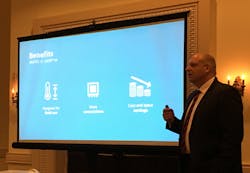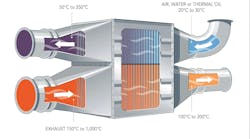Siemens brought its annual Automation Summit to Boca Raton, Florida, June 26–29, for end-user presentations, technology roadmaps and networking sessions under the sunny skies of the Sunshine State. The event kicked off with a keynote by Raj Batra, president of Siemens Digital Factory Division, who explained how Siemens is working to leverage digitalization to bridge billions of intelligent devices, machines and data between the virtual and real worlds in industrial application environments.
The cybersecurity discussion continues
Among the points of discussion at the show was cybersecurity, which is seen by many in the industrial process automation space as the key enabler (or disabler) — depending on your perspective — of industrial connectivity. One session at the Automation Summit focused on protecting against programmable logic controller (PCL)-based attacks. Titled "PCL Cyber-attack Detection," the session was noteworthy because a Siemens PLC was the target of the 2010 Stuxnet worm, which remains among the most prominent examples of a successful cyberattack on an industrial system.
During the session, Erlend Engum, sales and marketing director for Secure-NOK, explained that the number and sophistication of attacks on PLCs is on the rise. Common attack targets and types include internet-facing PLCs, PLC worms, attacks related to payload sabotage and the PLC Rootkit attack. Engum explained that the harm caused by such attacks depends on the process the PLC is controlling. For example, the PLC Rootkit attack, also referred to as the PLC ghost attack, can be particularly troublesome. The attack is executed by a number of steps, including:
- The attacker gains access to the PLC through malicious firmware in the PLC, either by guessing passwords or through a control-flow attack against the PLC runtime.
- The attacker maps the input/output to the debug register to intercept write and read operations; and
- The attacker manipulates the input/output (I/O) initialization sequence.
By gaining control over I/O, the attacker can manipulate physical processes, such as changing the value of a pressure-sensitive boiler, which could have disastrous consequences.
Given the increasing threat of cyberattacks in the industrial space, Siemens has partnered with Secure-NOK to develop and test a cyber-attack detection solution for PLCs. The solution covers the SIMATIC S7-300, S7-400, S7-1200 and S7-1500 series and addresses both brownfield and greenfield deployments. According to Siemens, the brownfield deployment does not require changes to the PLC.
Another session at the Automation Summit that touched on cybersecurity was titled "How Industrial Cybersecurity Protects and Enables the Digital Future." During this presentation, Mark Kunz, a Siemens product manager, explained how cybersecurity concerns are often the biggest obstacle companies face when considering the digitalization of their systems and the pursuit of Industrial Internet of Things (IIoT).
Kunz discussed the range of new security solutions built into Siemens’ open cloud-based platform, MindSphere. He explained that the open nature of this system provides end users the assurance of the most current security features and best practices to support multivendor automation on the plant floor and the secure connection of the plant with the outside world.
While cybersecurity remains a common point of discussion whenever suppliers bring up the concept of digitalization and IIoT, the Automation Summit also featured a wide range of case studies highlighting truly impressive uses of digital technology to modernize and drive efficiency in industrial settings.
The role of wireless
One example of how technology is being employed to free up process data to the advantage of an industrial application was highlighted during a presentation titled, "WiMax Radios Used in SCADA Communications Network." The session explained how the City of Georgetown, Texas, used wireless to upgrade its 900 MHz radio system for supervisory control and data acquisition (SCADA) communication to a fiber optic communication system. The challenge was providing fiber optic access to SCADA locations that were too remote to economically install cable.
Siemens WiMAX radios provided a solution, acting as a functional extension of the fiber optic network. This allowed for SCADA communications to the remote sites to be the same as they were on the actual fiber optic network. The biggest obstacle in this application was getting line-of-sight clearance between the base stations and the remote sites (i.e., getting above the hills and trees). The base stations were positioned on top of water towers to provide the maximum height possible. However, the subscriber units were located at sites that did not have structures readily available that would provide the required height. To overcome this issue, a geospatial analysis tool was used to create elevation profiles between the sites and calculate the minimum height needed for each subscriber. Utility poles and antenna towers were put in place to provide the necessary height, thus removing any line-of-sight obstructions and allowing the subscriber units to communicate with the base stations.
The role of virtualization
Virtualization is another hot topic in industry today. Well-established in the information technology world, virtualization is starting to gain prominence for industrial applications because of the efficiencies it offers for commissioning, testing and updating systems. In a virtualized environment, physical machines are replaced with software-based virtual machines managed through a centralized server. By consolidating infrastructure onto a single physical machine, the end user can implement updates and add new applications from a single location through software.
Louisiana Sugar Refining (LSR) in Gramercy, Louisiana, presented a session on virtualization at Automation Summit titled, "Making Sugar ‘Virtually’." During the presentation, LSR explained how it upgraded its PCS 7 V7.1 system to V8.2 using a virtualized architecture based on Siemens SiVaaS technology. According the LSR, the virtualized approach helped it save 10 to 15 percent in cost compared to a conventional upgrade.
"Virtualization allows an efficient method to keep pace with changing technology," said Jody Braud, Automation, Electrical & Instrumentation Manager at LSR. "Anybody who is considering virtualizing their system, I highly recommend it, it’s been a great tool for us."
Industrial networking in the modern age
Another interesting presentation at the Automation Summit explained how Constellation Brands expanded the capacity of what it says is now the world’s largest brewery. The session, titled "Best Practices and Lessons Learned in Industrial Networking in Building Out the World’s Largest Brewery," explained how Constellation leveraged Siemens technology on a plant-wide basis to build out its Nava Brewery in Piedras Negras, Mexico, from raw materials through finished goods.
The network architecture included SIMATIC PCS 7 for the process and utilities areas, SIMATIC PLC/HMI/WinCC for line integration, visualization and monitoring and SCALANCE network components for industrial communication on the packaging lines.
Chris Renken, director of automation for Constellation Brands, said the level of standardization it received by building its network on Siemens technology streamlined the project. "We went from dirt to startup in three years," he said, beating the expected launch date by about seven months.
Considering PROFINET upgrades
From among the sessions that I sat in on at Automation Summit, the one that generated the most attendee feedback was a presentation by Tony Lee, manager of process control for Evonik, and David Minto, senior controls engineer for Maverick Technologies, which explained how Evonik upgraded its Siemens TIASTAR Smart Motor Control Center from SIMOCODE PROFIBUS DP to SIMOCODE PROFINET Pro V.
Based on the active dialogue during this session, PROFINET upgrades remain an area of particular interest among end users who employ Siemens technology. The Evonik implementation detailed during this presentation required the use of a plant standard where the SIMOCODE handled the local motor start/stop pushbutton inputs from the field. The PROFINET upgrade enabled Evonik to provide centralized monitoring and control of its field-based motors using a Siemens PCS 7 APL control module.
Parting shots
All told, Siemens’ latest Automation Summit offered up a healthy dose of digital. Clearly the drumbeat of IIoT remains front and center, with most of the industry events over the past several years focused on solutions for modernizing industrial systems to enable end users to maximize their use of process data for process optimization. What’s interesting to see as we’re several years into the IIoT trend is that actual live applications and case studies are showing how the promise of IIoT-based solutions is producing real-world results.
Matt Migliore is director of content strategy for the Process Flow Network. He has covered technology and industry for 15 years. He can be reached at [email protected] or 484-255-9032.


